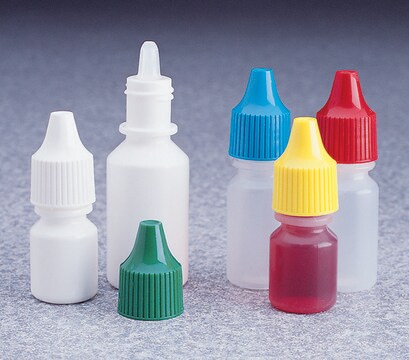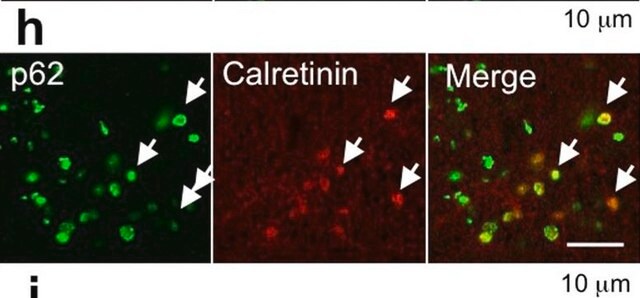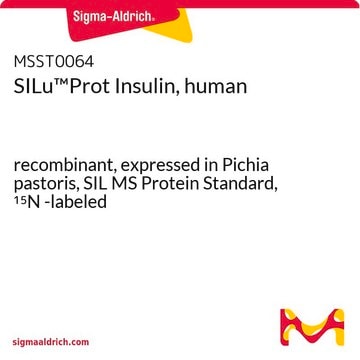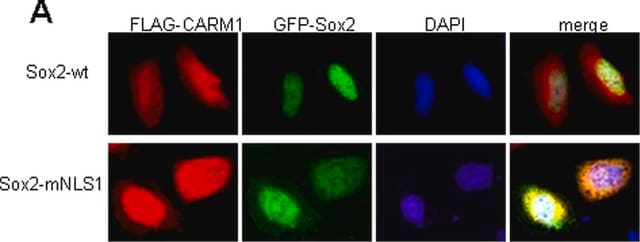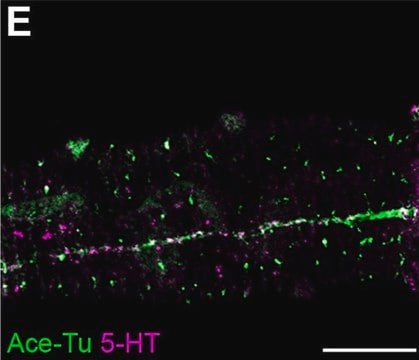추천 제품
생물학적 소스
rabbit
Quality Level
결합
unconjugated
항체 형태
whole antiserum
항체 생산 유형
primary antibodies
클론
polyclonal
포함
15 mM sodium azide
종 반응성
human
포장
antibody small pack of 25 μL
기술
competitive inhibition ELISA: 1:1000-1:2000
immunohistochemistry (formalin-fixed, paraffin-embedded sections): 1:8,000 using indirect immunoperoxidase staining of human stomach
UniProt 수납 번호
배송 상태
dry ice
저장 온도
−20°C
타겟 번역 후 변형
unmodified
유전자 정보
human ... CCK(885)
일반 설명
Cholecystokinin (CCK) belongs to gastrointestinal hormone family is a neuropeptide hormone and neurotransmitter usually present in gastrointestinal (GI) tract and the central nervous system (CNS). CCK functions include enzyme secretion from pancreas, gall bladder contraction, intestinal motility; CCK will also inhibit gastrin induced acid secretion . This product is also useful for the study of mode of action, differential tissue expression and intracellular and subcellular localization of CCK in CNS and in neuroendocrine cells of digestive system. Anti-CCK-8 reacts specifically with sulfated CCK-8 and shows cross reactivity with unsulfated CCK-8 and Big Gastrin I.
Cholecystokinin (CCK) is a neuropeptide hormone and neurotransmitter widely distributed throughout the gastrointestinal (GI) tract and the central nervous system (CNS). CCK, Big Gastrin I, and vasoactive intestinal peptide (VIP) belong to the gastrin/cholcystokinin family. hormone family. CCK has a biologically active C-terminal pentapeptide. CCK exists as a larger precursor hormone, preproCCK (114 amino acids), from which several smaller fragments are derived, sharing a C-terminal tetrapeptide and a sulfated tyrosine residue. Sulfated CCK (26-33) amide (CCK-8) is the major and the most potent CCK form in the brain and periphery. CCK is widely distributed in several brain regions, including the cerebral cortex, hippocampus, amygdala nuclei, and the hypothalamus. In the periphery, CCK is localized mainly in nerve fibers in the myenteric and submucosal ganglia, as well as in endocrine cells of the gastrointestinal tract.
면역원
Synthetic sulfated CCK-8 conjugated to KLH.
애플리케이션
Anti-Cholecystokinin (26-33) (CCK-8) has been used in
- immunohistochemistry
- double-label immunofluorescence staining
- immunocytochemistry
- ELISA immunoassay
Anti-cholecystokinin (26-33) (CCK-8) antibody can be used to detect CCK peptide in pancreatic cancer cells by immunocytochemistry. It may also be used for ELISA immunoassay.
Anti-cholecystokinin (26-33) (CCK-8) antibody can be used to detect CCK peptide in pancreatic cancer cells by immunocytochemistry. It may also be used for dot blot immunoassay.
생화학적/생리학적 작용
Cholecystokinin (CCK) stimulates enzyme secretion from the pancreas, gall bladder contraction, and intestinal motility and it inhibits gastrin-induced acid secretion. CCK may be involved in several physiological and behavioral functions such as satiety, anxiety, memory processes, and analgesia and in disorders such as panic disorder. In the central nervous system (CNS), CCK acts as a neurotransmitter and modulates the action of other neurotransmitters such as dopamine, 5-hydroxytryptamine (5-HT), γ-Aminobutyric acid (GABA) and excitatory amino acids. The multiple biological actions of CCK are mediated by two classes of receptors, the peripheral/brain CCK-A receptors and the brain CCK-B receptors.
면책조항
Unless otherwise stated in our catalog or other company documentation accompanying the product(s), our products are intended for research use only and are not to be used for any other purpose, which includes but is not limited to, unauthorized commercial uses, in vitro diagnostic uses, ex vivo or in vivo therapeutic uses or any type of consumption or application to humans or animals.
적합한 제품을 찾을 수 없으신가요?
당사의 제품 선택기 도구.을(를) 시도해 보세요.
Storage Class Code
10 - Combustible liquids
WGK
nwg
Flash Point (°F)
Not applicable
Flash Point (°C)
Not applicable
가장 최신 버전 중 하나를 선택하세요:
시험 성적서(COA)
Lot/Batch Number
이미 열람한 고객
Role of endogenous cholecystokinin on growth of human pancreatic cancer
Matters G L, et al.
International journal of oncology, 38(3), 593-601 (2011)
An introduction to neuronal cholecystokinin
Beinfeld MC
Peptides, 22(8), 1197-1200 (2001)
Distribution and ontogeny of gastrin-and serotonin-immunoreactive cells in the proventriculus of developing chick, Gallus gallus domestica
Aksoy A and Cinar K
Journal of Veterinary Science, 10(1), 9-13 null
Cholecystokinin and gastrin receptors
Dufresne M, et al.
Physiological Reviews, 86(3), 805-847 (2006)
Caroline Giezenaar et al.
Nutrients, 10(2) (2018-01-24)
Protein-rich supplements are used widely for the management of malnutrition in the elderly. We reported previously that the suppression of energy intake by whey protein is less in older than younger adults. The aim was to determine the effects of
자사의 과학자팀은 생명 과학, 재료 과학, 화학 합성, 크로마토그래피, 분석 및 기타 많은 영역을 포함한 모든 과학 분야에 경험이 있습니다..
고객지원팀으로 연락바랍니다.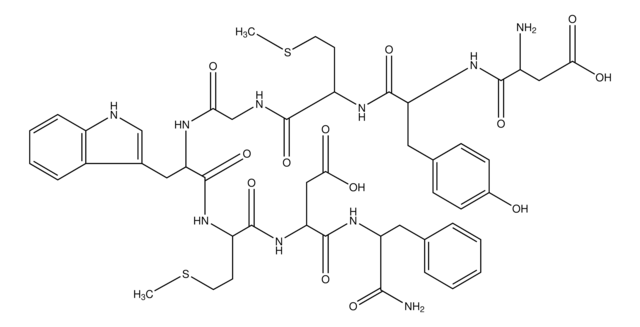
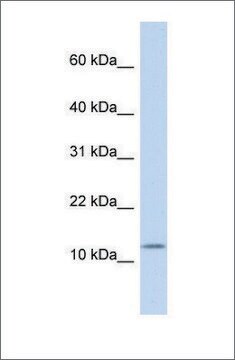
![(Tyr[SO3H]27)Cholecystokinin fragment 26-33 Amide ≥97% (HPLC), powder](/deepweb/assets/sigmaaldrich/product/structures/125/021/32eb71ec-73e5-4cfc-94d0-ebcf5e784e39/640/32eb71ec-73e5-4cfc-94d0-ebcf5e784e39.png)
